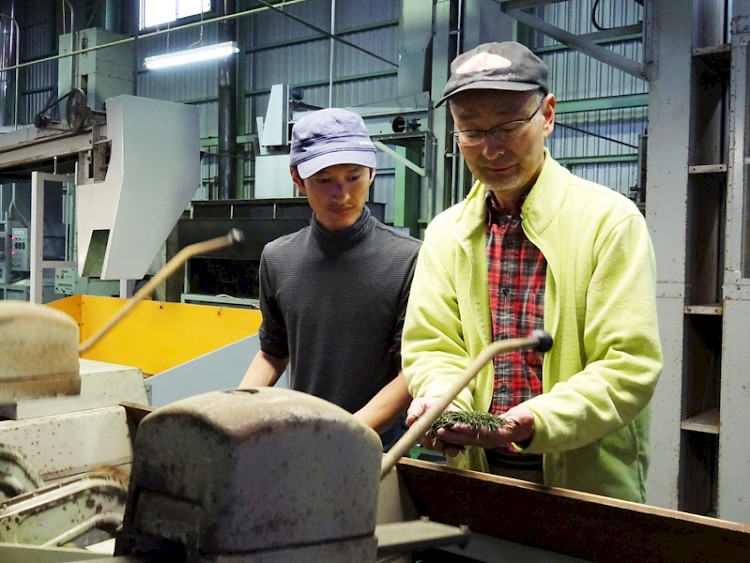
Yesterday we already talked on the phone with Shutaro Hayashi, on order to find out what kind of work they have planned for the next day (today, April 25th). After we heard from Shutaro, that family Hayashi is planning that today will be the first day of this year’s shincha and first flush harvest, we change our schedule for today and directly go to the organic tea garden of Hayashi family in Kirishima in the early morning. This year (2016) the first flush harvest begins comparably late, which may have good effects in the quality of the tea. Already since some weeks the most days are characterized by a lots of rain and it is still quite cold. The rain clouds in the sky seem to have a kind of effect, which may be called “naturaly shading” [ tennen kabuse ], how Shutaro Hayashi explains us. And yes, we see the effect: Even the not shaded tea bushes have very green leaves (meaning more a blue green on the colour scale than a yellow green or green with little red nuances).

While Shutaro Hayashi is working in the little tea production hall of the family, we take the opportunity to interview his father Osamu. We ask him, in how far his image of a perfect sencha is different from the image of his son Shutaro, how a perfect sencha should be. Osamu, the father of Hayashi family, tells us, that if he would still be the one managing the tea garden, he would have waiting one or two days more, and would not have started with the harvest already today. The reason for this is, that his ideal sencha should be characterized by a bit bigger leaves than his son Shutaro thinks, who more prefers smaller leaves. While Osamu know that his son Shutaro prefers a deeper steaming [ fukamushi ] of the fresh harvested tea leaves, his own thoughts of a perfect sencha would be to steamed not so deep, which is called “asamushi steaming”.
Therefore, the opinions of father and son are quite different, and as Osamu Hayashi tells us, this is strongly related to their era of tea production philosophy and tea culture, which is influenced by a strong change caused by changin taste preferences of the Japanese, and also be new possibilties thank to new machine types used for tea production. Many years ago the deep steaming, which is quite trendy nowadays, was not yet possible nor would it have been prefered, probably. When Osamu was yound, the ideal sencha was not so freshly green. The ideal was a green with a light nuance of yellow, which is a more moderat colors, like the colors in a traditional tea room for tea ceremony, were strong colors are to be avoided. Though, nowadays, in the era of Osamu’s son Shutaro Hayashi, a very bright and shiny, a bit lime-green nuance, is what is seen to be the perfect color of a sencha or kabusecha infusion. To produce such a lime-green sencha, it is not only important to harvest quite young and small tea leaves, but also the steaming has to be deeper [ fukamushi ]. Naturally, also a quite long shading time of the tea bushes has a positive effect to reach the goal of this “modern age perfect sencha.